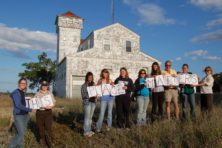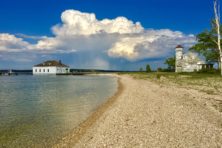Plum Island Boat Dock Now Open
- Share
- Tweet
- Pin
- Share

The U.S. Fish and Wildlife Service announces the opening of the Plum Island boat dock, due to recent improvements to the dock and breakwall. This is the first time the dock has been open since Plum and Pilot Islands were transferred from the U.S. Bureau of Land Management to the U.S. Fish and Wildlife Service in 2007.
The dock will provide access to Plum Island by providing moorage for both general public and commercial vessels. General public use moorage is on a first come first serve basis and is reserved to the public docking area. Commercial moorage is by Special Use Permit only and is reserved to the authorized vessel docking area. A map of docking areas, permit application and special conditions may be found at https://www.fws.gov/refuge/Green_Bay/.
Both the general public and commercial boaters must follow all public use regulations. The Service encourages all boaters to use caution and be courteous of other boaters.
Refuge Rules and Regulations:
- Plum Island is open during daylight hours only Memorial Day weekend through Labor Day for hiking, wildlife observation, interpretation, and photography on designated trails (mowed) and beach areas only.
- Use of boot brush stations is mandatory to prevent the spread of invasive species.
- Kayaks/canoes/dinghies must use designated landing areas (near boathouse on northeast side of the island and near the lighthouse on the south access) to decrease the spread of invasive species.
- Travel on Plum Island is restricted to foot travel on mowed trails. Wheel chair access is limited due to uneven terrain, and safest around the dock, boathouse, and Life Saving Station on the northeast side of the island.
- Dogs are welcome but must be leashed and pet waste picked up and removed.
The following activities are not permitted on Plum Island:
- Bikes and motorized forms of transportation are prohibited.
- Fishing from the dock or beach; swimming from the dock or other structures
- Fireworks; camping; campfires; and geocaches
- Feeding or harassing wildlife on the refuge is a violation of federal law.
- Collection of plants, berries, seeds, mushrooms, rocks, fossils, antlers, or other artifacts;
- All of the refuge’s historical, archaeological, and natural resources are protected. Artifact hunting is not allowed. Rule of thumb: If it was found there, it must stay there.



